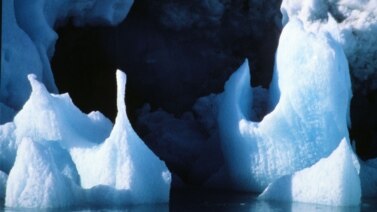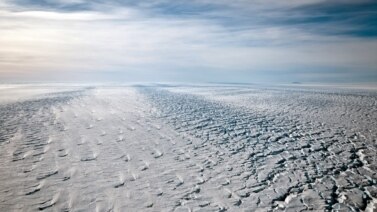
BOB DOUGHTY: This is SCIENCE IN THE NEWS, in VOA Special English. I’m Bob Doughty.
SHIRLEY GRIFFITH: And I’m Shirley Griffith. Today, we tell about methane gas thought to be trapped under ice-covered areas of Antarctica. We also tell about the growing use of generic drugs in fighting HIV, the virus responsible for AIDS. And we have a report on the search for an effective vaccine against HIV.
(MUSIC)
BOB DOUGHTY: An international team of scientists has found that up to four billion tons of methane gas could be trapped under ice-covered areas of Antarctica. The scientists say extremely small organisms may have changed ancient organic matter into methane. And they say if enough ice melts, it is possible that enough of the gas could escape and add to the warming of Earth’s atmosphere.
Jemima Wadham of Bristol University in Britain directed the study. She says the amount of organic carbon recorded is more than ten times the size of all carbon supplies in Earth’s northern permafrost areas. The journal Nature published her report about the findings.
Sandra Arndt also worked on the study. At the time, she was with Utrecht University in The Netherlands. She says the high pressure and cold temperatures under the ice make good conditions for forming methane hydrate. And she says it was not surprising that the study confirmed the presence of methane hydrate. The substance is a solid similar to ice. It is formed when methane gets trapped within a structure of water molecules.
SHIRLEY GRIFFITH: The continent of Antarctica is mainly over the South Pole, almost totally south of the Arctic Circle. The scientists say the organic material came from a period thirty five million years ago. At that time, Antarctica was much warmer than today and contained life forms.
Researcher Slawek Tulaczyk of the University of California at Santa Barbara described how methane formed. She said some of the organic material became trapped in material that had fallen to the bottom. She said these sediments, in her words, were then “cut off from the rest of the world when the ice sheet grew.”
The scientists say fifty percent of the West Antarctic ice sheet and twenty-five percent of the East Antarctic sheet are on sedimentary basins. They said these areas hold about twenty one billion tons of carbon.
BOB DOUGHTY: The Antarctic Ice Sheet covers land, but not the surrounding sea. Methane hydrates are also found at the bottom of oceans.
Earlier this year, news about methane gas came from the opposite end of the world. Researchers reported finding thousands of places in the Arctic where the gas was rising to the surface.
Studies on the ground and from the air found one hundred fifty thousand seeps -- places in Alaska and Greenland where methane had escaped. The seeps were found in lakes along the edges of ice cover.
SHIRLEY GRIFFITH: The study appeared in the journal Nature Geoscience. It showed that some of the seeps are freeing ancient methane. The source may be natural gas or coal deposits beneath the lakes.
Other seeps release more recently formed gas. The newer methane may have formed when plant material in the lakes broke down into basic elements.
Another scientist involved in methane research described the Arctic area as the fastest-warming area on Earth. Euan Nisbet from the University of London said the area has many methane sources that will increase as the temperature rises. He says there is a serious concern that the warming could cause more warming.
Some scientists believe the effects of the freeing of methane will not be seen for many years. Others note that the possibility of a fast methane release could speed up rising temperatures on Earth.
(MUSIC)
BOB DOUGHTY: An American program called the President’s Emergency Plan for AIDS Relief helps millions of people infected with HIV, the virus responsible for AIDS. PEPFAR is considered one of the most successful programs created during the presidency of George W. Bush. Its goal was to change HIV/AIDS from a death sentence to a disease that, while serious, could be treated. And for millions of people around the world, that is just what happened.
But researchers say it was not until PEPFAR started using generic drugs that major progress was made in fighting HIV/AIDS. Generic drugs are copies of medicines developed by large drug companies. But they often cost a lot less.
SHIRLEY GRIFFITH: Researchers from Brown University in Rhode Island studied the effectiveness of PEPFAR. Kartik Venkatesh was the lead author of a report on the study. He says the high cost of patented antiretroviral drugs had an immediate influence on the program after it began.
American officials considered whether to provide patented drugs to HIV-infected patients, both in the United States and overseas. Dr. Venkatesh says some people believe that the drug industry wanted the government-financed program to use patented drugs.
But generic drugs were shown to be effective in treating HIV as far back as two thousand three. Using generic drugs helped cut the cost of treating a person from about one thousand one hundred dollars a year to about three hundred dollars a year in two thousand five.
BOB DOUGHTY: PEPFAR has also been able to save millions of dollars by reducing transportation costs -- for example, using ships instead of airplanes to move the drugs. Dr. Venkatesh says the PEPFAR model could be used in the fight against other diseases as developing countries begin seeing health problems that until recently had only been seen in richer countries.
DR. KARTIK VENKATESH: “There is a movement towards understanding that the real and perhaps potentially larger burden in the future is also going to be chronic diseases like cardiovascular disease, diabetes (and) cancer. And those are also diseases that require chronic, long-term medication. A lot can be learned from the experience about accessing generics for the treatment of HIV.”
The Brown University researchers have proposed creation of a plan for what they call the “efficient and transparent” purchase of generic drugs. Planners would include the United States, the World Health Organization and the makers of generic drugs.
(MUSIC)
SHIRLEY GRIFFITH: The search for an effective vaccine against HIV has been called one of the greatest scientific challenges of our time. For the past eleven years, the Vaccine Research Center at America’s National Institutes of Health has been taking part in the search. There have been many successes and failures. But the scientists working at the center are more hopeful than ever they will develop a vaccine.
Guy Jenkins-Bass has been infected with HIV for more than ten years. Like millions of HIV-positive people, anti-retroviral drugs have given him the freedom to live a normal life. He is thankful for the care he receives at the Whitman Walker Clinic in Washington, DC. He hopes that one day there will be a vaccine to prevent HIV infection, and maybe even a cure.
GUY JENKINS-BASS: “I would love to see a cure for it. That would be even better. But it’s not like they’re not trying -- I mean I know people are trying to find a cure.”
BOB DOUGHTY: Gary Nabel has spent more than ten years working to develop a vaccine at the Vaccine Research Center. He says when he started, it seemed like a never-ending project. But he is pleased with the developments of the past few years.
DR. GARY NABEL: “I would have to say from my own personal experience, the high point was probably our ability to identify one of the most broadly-neutralizing antibodies that we’ve yet discovered against HIV.”
Broadly-neutralizing antibodies defend cells in the body from attackers like HIV. The discovery of how they can control the virus has opened up a new way of thinking.
DR. GARY NABEL: “And so there’s a whole parallel approach now where we can begin to engineer these antibodies so that we can give them as infusions into people who may be at high risk to block the infection.”
SHIRLEY GRIFFITH: The Vaccine Research Center has begun testing different antibodies in monkeys. The antibody is given to uninfected monkeys. Then, the animals are left exposed to a level of virus that would normally infect them.
DR. GARY NABEL: “Several of them look very, very promising. They’re inhibiting, they’re blocking infection. They’re blocking them at relatively low doses.”
Dr. Nabel and his team are preparing to launch human tests early next year.
DR. GARY NABEL: “If we can do these trials and show that the antibodies block infection in people, it essentially validates the target of those antibodies for vaccines. It also gives us information about -- quantitative information -- if we’re able to block, what levels of antibodies do we need to achieve in order to prevent it (HIV)?”
Dr. Nabel says even if the tests are successful, there is still more work to be done before a vaccine can be developed.
(MUSIC)
BOB DOUGHTY: This SCIENCE IN THE NEWS was written by Christopher Cruise and Jerilyn Watson. Our producer was June Simms. I’m Bob Doughty.
SHIRLEY GRIFFITH: And I’m Shirley Griffith. Join us again next week for more news about science in Special English on the Voice of America.



